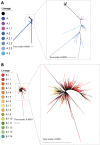Mpox Virus: Its Molecular Evolution and Potential Impact on Viral Epidemiology
- PMID: 37112975
- PMCID: PMC10142743
- DOI: 10.3390/v15040995
Mpox Virus: Its Molecular Evolution and Potential Impact on Viral Epidemiology
Abstract
Mpox (previously known as monkeypox) is an infectious viral illness caused by the mpox virus (MPXV), an orthopoxvirus that belongs to the family Poxviridae. The symptoms of mpox in humans are similar to those of smallpox, although the mortality rate is lower. In recent years, the concern over a potential global pandemic has increased due to reports of mpox spreading across Africa and other parts of the world. Prior to this discovery, mpox was a rare zoonotic disease restricted to endemic regions of Western and Central Africa. The sudden emergence of MPXV cases in multiple regions has raised concerns about its natural evolution. This review aims to provide an overview of previously available information about MPXV, including its genome, morphology, hosts and reservoirs, and virus-host interaction and immunology, as well as to perform phylogenetic analysis on available MPXV genomes, with an emphasis on the evolution of the genome in humans as new cases emerge.
Keywords: epidemiology; molecular evolution; mpox virus.
Conflict of interest statement
The authors declare no conflict of interest.
Figures



Similar articles
-
Pandemic potential of poxviruses: From an ancient killer causing smallpox to the surge of monkeypox.Microb Biotechnol. 2023 Sep;16(9):1723-1735. doi: 10.1111/1751-7915.14294. Epub 2023 Jun 19. Microb Biotechnol. 2023. PMID: 37335284 Free PMC article.
-
Molecular epidemiology of the 2022 monkeypox virus outbreak in Slovenia.Acta Dermatovenerol Alp Pannonica Adriat. 2023 Sep;32(3):111-117. Acta Dermatovenerol Alp Pannonica Adriat. 2023. PMID: 37749971
-
Mpox diagnostics: Review of current and emerging technologies.J Med Virol. 2023 Jan;95(1):e28429. doi: 10.1002/jmv.28429. J Med Virol. 2023. PMID: 36571266 Free PMC article. Review.
-
Human monkeypox virus in the shadow of the COVID-19 pandemic.J Infect Public Health. 2023 Aug;16(8):1149-1157. doi: 10.1016/j.jiph.2023.05.013. Epub 2023 May 13. J Infect Public Health. 2023. PMID: 37269693 Free PMC article. Review.
-
Monkeypox Virus in Nigeria: Infection Biology, Epidemiology, and Evolution.Viruses. 2020 Nov 5;12(11):1257. doi: 10.3390/v12111257. Viruses. 2020. PMID: 33167496 Free PMC article. Review.
Cited by
-
Innate Immune Response to Monkeypox Virus Infection: Mechanisms and Immune Escape.J Innate Immun. 2024;16(1):413-424. doi: 10.1159/000540815. Epub 2024 Aug 13. J Innate Immun. 2024. PMID: 39137733 Free PMC article. Review.
-
Monkeypox: A New Challenge for Global Health System?Life (Basel). 2023 May 25;13(6):1250. doi: 10.3390/life13061250. Life (Basel). 2023. PMID: 37374034 Free PMC article. Review.
-
The pressing need for study on the effects of Mpox on the progression of vascular inflammation: A well-timed call.Health Sci Rep. 2024 Jun 28;7(7):e2223. doi: 10.1002/hsr2.2223. eCollection 2024 Jul. Health Sci Rep. 2024. PMID: 38946778 Free PMC article.
-
Sinefungin analogs targeting VP39 methyltransferase as potential anti-monkeypox therapeutics: a multi-step computational approach.Mol Divers. 2025 Feb;29(1):561-574. doi: 10.1007/s11030-024-10875-z. Epub 2024 May 4. Mol Divers. 2025. PMID: 38702561
-
Genomic characterization and molecular evolution of human monkeypox viruses.Arch Virol. 2023 Oct 21;168(11):278. doi: 10.1007/s00705-023-05904-5. Arch Virol. 2023. PMID: 37864757
References
-
- CDC Mpox in the U.S. [(accessed on 15 January 2023)]; Available online: https://www.cdc.gov/poxvirus/monkeypox/response/2022/world-map.html.
Publication types
MeSH terms
Grants and funding
LinkOut - more resources
Full Text Sources

